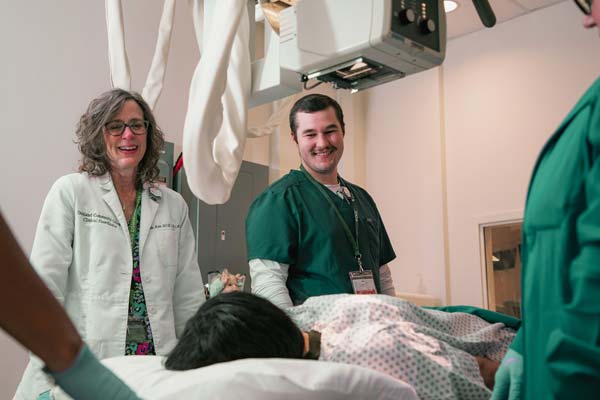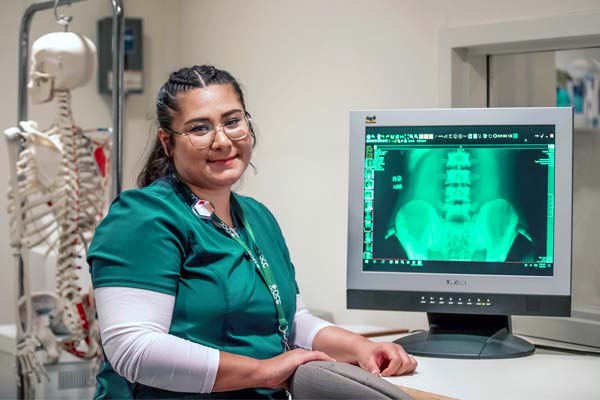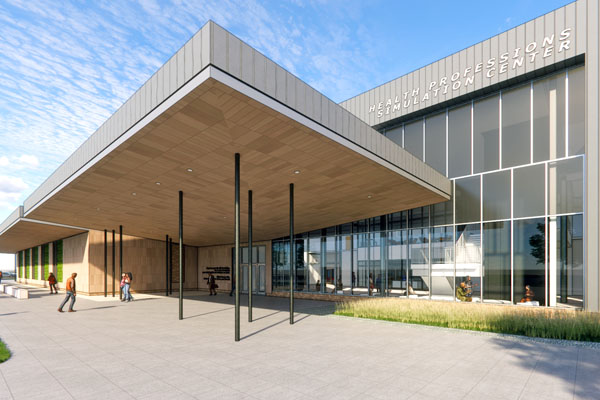Interprofessional Simulation Center
Practice Your Way to Better Patient Care
Imagine yourself in your patient’s room, the monitors beeping, alarms sounding nearby, and your patient looking at you expectantly. Our state-of-the-art Health Sciences Simulation Center is a risk-free place for you to learn and practice providing good patient care with safe outcomes.
With each simulation, you take specific ideas you heard in class and apply them to realistic patient care scenarios you’ll encounter in the field. As you practice, you learn. Theory becomes knowledge. Your confidence and competence soar.
Life-like, Safe Settings for Learning & Practice
In the center, you work in teams, learning to communicate and collaborate with students in other programs—just as you will in real life. Here, professional instructors prepare and manage the scenarios. After each scenario, you and your group reflect on and learn from the events.
These key features of the center support your learning:
- High-Fidelity Mannequins: Life-like patient simulators that breathe, have a pulse, and can vocalize. Those signs change during the scenario. The mannequins can respond to medication, for example.
- Standardized Patients: Trained actors. Your group interacts with real people. You can ask questions, give directions, and read nonverbal cues. This lets you refine your patient assessment and interpersonal skills.
- Debriefing Rooms: Dedicated spaces for group discussion. You can review your performance, receive constructive feedback, and discuss strategies for improving.
See Yourself in the Sim Lab
As you prepare for your future role in healthcare, you may spend time in simulations. The amount of time spent in the simulation lab varies by program. For example, nursing students can use the simulation center for up to half of their required clinical hours.
The sim lab is a great complement to clinical studies and coursework in programs such as:
- Diagnostic Medical Sonography
- Healthcare Administration
- Medical Assisting
- Nursing
- Radiologic Technology
- Respiratory Therapy
- Surgical Technology
A Safe Space to Learn & Grow
This is a place for reflection, not perfection. It’s OK to make mistakes in the simulation center – in fact, everyone does it. Some of your greatest “aha” moments will come by learning from the mistakes you and your peers make.
You’ll work with a variety of mannequin “patients” during your scenarios to help you get comfortable caring for infant, child, and adult male and female patients.
Pre-briefing
The pre-briefing session orients you to the scenario. Going into the simulation, you learn the type of patient you will see that day and why they ended up in your care. We tell you what you need to know to set you up for success and reduce unnecessary stress.
In your simulations, you encounter both patients and family members, for a good test of your hard and soft skills. Scenarios vary to allow you to practice many different patient-care situations.
Simulation
During the scenario, you provide care to the simulated patient. These are immersive experiences. Sometimes you practice common situations. Other times you practice high-risk, low-volume situations that occur less frequently but with higher stakes and more adrenaline.
For some simulations you work alone. For others, you work in a team. You may even work alongside students from other healthcare programs. This helps you understand everyone’s role in the patient care process and where you fit in.
Debriefing
After the simulation, you reflect and grow during the debriefing session. At the new Orchard Ridge location, you will be able to watch a video of your scenario with instructors and peers.
Ask questions, conduct critical thinking, and be vulnerable as a learner. In the debriefing room, you talk about how the scenario went – what went well, and even more importantly, how you can improve for next time.
This is a safe space for you to become better at patient care. You won’t be judged or criticized for how you did or what happened in the lab. Your instructor is here to encourage and guide you as you prepare for your future role in health care.
Putting Theory to Practice in the Sim Lab





New Health Science Building, Opening in 2027
In 2027, the health sciences programs will move to the new state-of-the-art Health Sciences building on our Orchard Ridge Campus. Here, you will meet and work with expert caring faculty, staff, and students in all the healthcare disciplines – just as you’ll experience in the field.
Check out the New Facilities
Continuing Ed & Certifications
Community members can take healthcare continuing education courses and maintenance certifications at the OCC Health Sciences Simulation Center.
I’m Ready. Let’s Get Started!
- Apply to OCC. If you’re not already an OCC student, create a profile and complete our online application.
- On the application, select your program of interest.
- Existing OCC students can update their academic program using the Change of Program Form.
- Register for a required program information session.
Contact Information
Need help deciding your next steps or have a question? Reach out to Counseling. They can help you with the next step for you to achieve your goals.